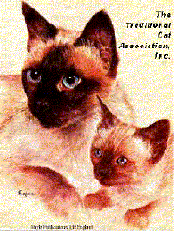|
THE TRADITIONAL©®
TONKINESE and TRADITIONAL LONGHAIR©® TONKINESE FAQs
Traditional Tonkinese Breeders
The Tibetan
is also known as our Trditional
Longhair Tonkinese.
Copyright , June 14, 2000
Diana Fineran
|

|
Click on pictures
to enlarge |

|
Q: What is the history of the Traditional Tonkinese?
A: The earliest mention of the breed of cat we have come to know as the
"Tonkinese" came in "The Cat Book Poems" written in Siam
(now Thailand) in the Ayudha Period (1300-1767). Called the Thong Daeng,
Suphalak or Coppers, they were grouped together with the Burmese. Simply stated
they came in light and dark colors. The Traditional Burmese, Classic Burmese
(dark colored) and the Tonkinese (light colored) are found in Thailand today.
(Please see the TCA, Inc. presentation of the Thai Cat Breeds). The next
historical presentation came in Francis Simpson's 1902 book, "The Book of
the Cat", where the Tonkinese is mentioned in the "Siamese"
section, but with no breed name. Why this blurry connection with the Burmese and
Siamese breeds, where both existed for centuries in Thailand? The history of the
Tonkinese bares the truth of it.
The Tonkinese is a blend of both the Siamese and Burmese breeds. By the
ancient texts and in testimonials in books over 100 years old, this type of cat
was created by Mother Nature in its native Thailand. Scientifically speaking the
Burmese and Siamese each have a variation of a gene that changes coat color from
black to dark brown, then lightens the color on the cats torso. The Burmese gene
produces a pattern called solid (or sepia), while the Siamese gene produces a
pointed pattern.
The combination of the two genes, creates the "Mink" pattern for
which the Tonkinese breed is best known. In this coloration the body displays a
medium to pale shade of the corresponding darker point color found on the facial
mask, ears, legs, paws and tail. The term "Mink" came about as a
description of the lustrous, silky texture of the close lying fur. This term
also defines the coat pattern as well.
In the mid-1950"s a New York City pet show owner named, Milan Greer,
crossed a Colorpoint Siamese and Burmese cats to form a new variety he named
"Golden Siamese". He discontinued the project before he had bred
enough "Golden Siamese" to carry on the name.
A deliberate cross breeding between Siamese and Burmese was done by Margaret
Conroy in Canada in the 1960's. She too used the name "Golden
Siamese". Then the name was changed to "Tonkanese", and finally
to "Tonkinese". It was Conroy and other dedicated breeders who
presented the Tonkinese to the cat world for acceptance into their show rings.
The Tonkinese is a pleasing blend of the best of both breeds, with
intermediate body type and good musculature.
Q: What is the Personality of the Tonkinese ?
A: Energetic, and active, Tonkinese thrive on attention from people, and
adjust well to children, dogs or other cats. Their love of riding on people's
shoulders is legendary. The gift of gab was inherited from its Siamese forbear,
because the Tonkinese talks in sentences and paragraphs. You are expected to
listen. However, their voice is more moderate in tone than the Siamese.
Boundless reserves of energy, that need limitless outlets, they show joyful
curiosity for the world around them. Their easy to groom short coat is silky and
elegant. They're playful, and inventive, but not excessively mischievous or
noisy, and adapt to almost any home. They have the intelligence and curiosity of
the Siamese with a more laid-back personality of a Burmese. Tending to be very
healthy cats, they live into their upper teens. Their appearance and low
maintenance lifestyle draw cat lovers to them.
Copyright , June 14, 2000
Diana Fineran
|

 The
Traditional Cat Association,
Inc.©1987®TM
Official Website
The
Traditional Cat Association,
Inc.©1987®TM
Official Website

